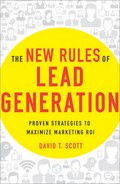The Big Picture: Qualifying Leads
Most companies have a process of qualifying leads. This process enables them to separate the good leads from the bad and to focus attention on actionable leads—that is, on courting potential customers who might actually buy the product or service. As a lead-generation marketer, you need to understand the “big picture” of how the lead-qualifying process works and how this process can have a positive or negative effect on your business’s bottom line.
There are several levels of leads that lead up to an actual sale of your product. A marketing lead (ML) is any lead that comes in to your organization. It may be a lead that will lead to a sale. Or it may be from a person who has no interest in the product, and just filled out the form because they liked the look of it, or to get whatever free giveaway you are offering on your website, at a trade show, etc.
Some of the initial MLs you collect will be useless to you (which is fine). There will usually be some bad leads from people with no interest in your products. There may be duplicate leads where the potential customer accidentally sent you the same online form twice, or leads where the customer provided bad data (i.e., the wrong phone number or an incomplete e-mail address).
Also, some leads may be from prospective customers who are not ready to buy, but who are still interested in the product. Most companies save these leads and continue to send appropriate marketing materials to the prospective customers until they are ready to make a buying decision. Usually, these leads go into a “drip bucket” so that the company can “drip” marketing communications to these potential customers in the hopes that they will eventually become active buyers.
Your responsibility as a marketer is to qualify leads before handing them off to your sales organization. Unless you are a strict e-commerce company, you need to have a process or measures in place to weed out the bad or duplicate leads. For example, you might have a member of your marketing staff give a phone call to marketing leads to see how interested they are in your products. Or you might have questions in your fill-out form to help you gauge the potential customer’s interest. (Example: “How often do you buy our type of product? ( ) Once a month. ( ) Once a year. ( ) Once every 10 years.”)
Once you qualify certain leads as being good ones that might result in a sale, those leads become marketing-qualified leads (MQLs). You then pass your MQLs on to your sales organization, where they become sales leads (SLs).
Often, sales departments have their own procedures to further qualify SLs, turning them into sales-qualified leads (SQLs). For example, a salesperson may place a follow-up call to ask customers whether they currently have a budget to buy the product. In some cases, the sales department may narrow the list even further by separating SQLs from sales-qualified opportunities (SQOs). An SQO may be a potential customer who is not yet ready to buy but who is definitely planning to buy within the next year. (Note: SQOs may also be defined as potentials, prospects, etc., depending on the kind of sales management software you use.)
The final stage in the process is getting the customer to buy. This is where the SQL turns into an actual sale.
Here’s the important thing to keep in mind: Each time you go through a qualification step, the number of leads that can potentially be turned into sales will probably be reduced. You may start with 100 MLs, but, once you qualify those leads, you reduce the number to 50 MQLs. Those 50 MQLs become 50 SLs, but your sales staff then reduces them to 20 SQLs.
In general, the overall cost of turning a lead into a sale increases each time you qualify leads. For example, it may cost you $1,000 to obtain every 100 MLs. At that point, your cost-per-ML is $1,000 ÷ 100 = $10 per ML. But let’s say that out of 100 MLs you obtain, only 10 of those MLs become MQLs. Your cost-per-MQL is $1,000 ÷ 10 = $100 per MQL. Your sales organization will take those MLs, turn them into SLs, and further qualify them. If only 5 SLs become SQLs, your cost-per-SQL is $1,000 ÷ 5 = $200 per SQL. If only one of those five SQLs results in a sale, your CPS is $1,000 ÷ 1 = $1,000 per sale.
This $1,000 CPS may provide either a positive or negative ROMI to your company. It depends on your product and the price at which you sell it. If you are selling pleasure yachts at a price of $700,000 each, a $1,000 CPS may be quite attractive. But if you are selling a $50 gift certificate to a restaurant, a $1,000 CPS is way too much.
